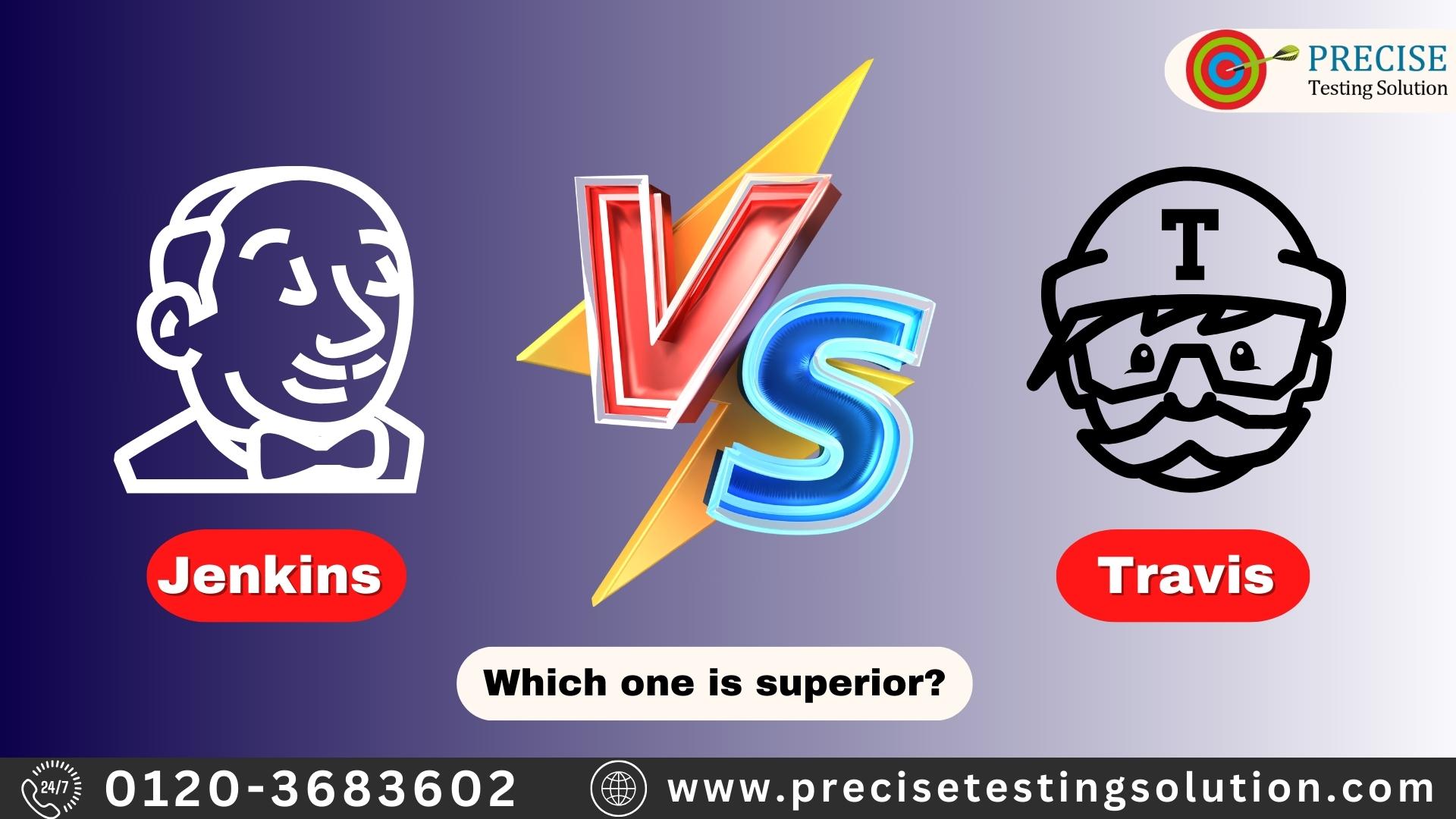Jenkins vs Travis CI, Which one is superior?
Through this blog post, we’ll look at Jenkins vs Travis CI, two of the most popular and commonly used CI/CD tools. The purpose of writing this blog post is for businesses to understand and gain comprehensive information about these two CI/CD tools so that they can utilize both as per their business requirements.
Any software development team can benefit greatly from Continuous Integration and Continuous Delivery (CI/CD) tools, which make it possible to build, test, and deploy software applications rapidly and efficiently. New features and upgrades may be distributed to users more quickly and easily thanks to these technologies. CI/CD tools can speed up software development, lower the chance of manual errors, and shorten the time needed to release a new version into production by successfully automating the entire software development process. With a shorter cycle time, DevOps teams can produce high-quality software applications more quickly and with greater agility.
Let’s Begin!
Jenkins: The Open-Source Powerhouse
Jenkins is an open-source automation server that facilitates continuous integration and delivery. It’s written in Java and offers extensive plugin options, making it highly customizable to fit various development needs.
Key Features:
- Extensive Plugin Ecosystem: With over 1,000 plugins, Jenkins allows integration with most CI/CD tools, enabling a broad range of automation tasks.
- Highly Customizable: Jenkins can be configured according to specific project requirements, offering flexibility in building, testing, and deploying applications.
- Self-Hosted: You have complete control over your Jenkins instance, which can be crucial for projects with specific security or privacy requirements.
Pros:
- Adaptability: Jenkins’ open-source nature and extensive plugin library mean it can adapt to almost any CI/CD requirement.
- Large Community: A vast community contributes to its extensive documentation, plugins, and support forums.
Cons:
- Complex Setup and Maintenance: Jenkins’ flexibility comes with complexity, making it potentially challenging to set up and maintain, especially for beginners.
- Resource Intensive: It can be resource-heavy, requiring more infrastructure investment, particularly for larger projects.
Travis CI: The Cloud-Native Solution
Travis CI is a hosted, distributed continuous integration service used to build and test software projects hosted on GitHub and Bitbucket. It provides a seamless integration with GitHub repositories, simplifying the CI process for projects hosted there.
Key Features:
- Easy Integration with GitHub: Travis CI offers out-of-the-box support for projects hosted on GitHub, making setup and integration simple.
- Configuration as Code: Projects are configured through a
.travis.ymlfile in the root of the repository, streamlining the configuration process. - Free for Open Source: Travis CI is free for open-source projects, making it an attractive option for community-driven projects.
Pros:
- Simplicity and Ease of Use: Setting up Travis CI is straightforward, especially for GitHub-hosted projects, making it ideal for small to medium-sized projects.
- Managed Service: Being a cloud-based service, Travis CI takes care of maintenance and updates, reducing the overhead for users.
Cons:
- Limited Customization: Compared to Jenkins, Travis CI offers limited customization options, which might not suffice for complex CI/CD workflows.
- Cost for Private Repositories: While free for open-source projects, private repositories require a paid subscription, which can be a consideration for commercial projects.
Jenkins vs Travis CI: Which one is better?
Let’s discuss a thorough parameter-based comparison of Jenkins and Travis CI to decide which of these two CI/CD tools businesses should favor most.
1. Setup and Installation
Jenkins is a stand-alone Java application that works flawlessly from the start. Popular operating systems including Windows, macOS, and UNIX all support access to it.
Jenkins is simple to set up and install because the process only requires a few steps:
Step 1 – Get the most recent Jenkins war file by downloading it from the Jenkins website. Next, copy the war file into the newly created directory for your Jenkins installation. Run the war file with the java -jar command to activate Jenkins.
Step 2 – When Jenkins is ready to use, open your web browser and navigate to http://localhost:8080/. There, you can start setting up your Jenkins server. You might add additional plugins or make new jobs, for instance.
On the other hand, you must join up using GitHub to begin utilizing Travis CI with GitHub. The YAML file.travis.yml (root directory) must be added to the repository, and the repository must be enabled for testing in the Travis Settings Page. As soon as Travis is installed, it will automatically run the test suites and handle any changes that must be pushed into the specified repository.
2. Usage
Jenkins has always given functionality a higher priority than usability. From the file system where it is stored, the administrator can quickly edit the basic XML file containing all of the configurations. In contrast to carrying out the identical task through the UI, updates may be promptly distributed across numerous Jenkins projects as a result. However, because of its close interaction with GitHub, Travis CI is the preferred CI/CD technology. Using Travis CI, businesses may autonomously test variants and request updates.
3. Parallel Test Execution
The Parallel Test Executor Plugin allows Jenkins to run many tests simultaneously. Multiple builds share the same environment when utilizing Jenkins’ simultaneous builds functionality, which could cause issues when attempting to access shared resources like the file system. The development phases of Travis CI can also be used for parallel execution. Build stages are used to arrange jobs and carry out the necessary jobs simultaneously. However, the procedures must be followed in the correct sequence. To sum up, Jenkins and Travis CI are both effective tools for carrying out parallel test execution. Businesses are free to select whatever option best suits their needs.
4. Applications and Plugin Ecosystem
Jenkins is an open-source software that depends on community expansion to grow its robust ecosystem of plugins. Jenkins now provides more than 1500 plugins. In addition to enabling build, deployment, and automation, each has a major commitment to the community. Jenkins is expandable because there are numerous plugins available. Contrarily, Travis CI supports 21 different programming languages, including C, C++, Perl, Java, Python, PHP, JavaScript, Node.js, and others. You can download Travis CI applications that the community has developed depending on your preferred language.
5. Community Support
Due to its open-source nature, Jenkins enjoys excellent online community support. Troubleshooting, knowledge sharing, documentation, reviews, and other duties can all benefit from the Jenkins community. The Jenkins Community Blog is additionally updated frequently. The Travis CI, on the other hand, is divided into several sub communities, including enterprise, deployment, discussion, languages, feedback, environments, and more. Travis CI does not, however, have the vibrancy of an online community, and neither do its plugins (or applications) or community support. Businesses looking for CI/CD solutions specifically for open-source projects should test both options out and choose the one that best satisfies their requirements.
6. Cloud and Third-party Integration
In addition to GitHub and Bit Bucket, Travis CI is a cloud-based continuous integration server that allows developers to add repositories from other servers as sub-modules. Travis CI, on the other hand, is free to use if the source code is accessible to the public. Popular cloud service providers like Azure, AWS, Google Cloud, etc. have built-in plugins for it. These plugins help you combine new GitHub projects with older ones. Performing builds on GitHub events and configuring build settings are also made easier by using them. Jenkins can be used by supporting integration with well-known cloud platforms. Jenkins can be integrated into cloud computing infrastructure like Google Cloud, Digital Ocean, Microsoft Azure, and Amazon EC2 using plugins, according to DevOps teams.
7. Hosting
Jenkins is available in on-premises and cloud-based hosting setups. It is a tool that may be used for free; the only expense associated with using it (in on-premises mode) is the cost of setting up the on-premises infrastructure. Although the corporate version of Travis CI may also be hosted on-site, the open-source and free version is only available in the cloud. The Enterprise edition enables you to perform CI tests locally on your servers or in your own cloud. Some of the supported cloud and on-premises providers include Google Compute Engine, Open Stack, AWS, VMware, and Azure. Travis CI Enterprise also gives your team access to information about and control over its building processes. To sum up, if you’re looking for a free (and open-source) CI/CD tool for a cloud or on-premises environment, Jenkins is a good option. In terms of usability, Travis CI is a good choice for open-source projects. The needs and budget of your project are the only considerations when choosing Travis CI Enterprise.
8. Extended Customization
RESTful APIs are available for specialized extensions in Jenkins and Travis CI. The 2017 release of API V3 resulted in a recent upgrade to the Travis CI APIs. The API version V2 is not regarded as deprecated because it appears to be in use for Travis CI’s web front-end applications. Like this, the Ruby Library for Travis CI is based on API V2. Jenkins provides remote monitoring APIs in Python, XML, and JSON. These APIs can be used to launch builds, create tasks, and more. The documentation may be quite helpful when using Jenkins APIs with your project.
Conclusion
In the end, to conclude this blog post, one thing that is clear from the comparison is that both Jenkins and Travis CI provide outstanding features. Because of its close relationship with GitHub, Travis CI provides an edge over Jenkins if you use that platform for version control. Jenkins, on the other hand, has been created, has been in use for a very long period, and is utilized by both entrepreneurs and big businesses. Businesses should consider the cost and in-house knowledge when comparing Jenkins vs Travis CI, as well as the capabilities, when filtering down a CI/CD system.
Contact Precise Testing Solution whether you want to use CI/CD tools like Jenkins or Travis CI to outsource any automation projects. Being accredited by STQC and CERT-IN, we are a reputable company offering ready-made solutions with powerful features, such as extensive test management, user administration, and security.
For more information, visit our website at www.precisetestingsolution.com
Call our office @ 0120-3683602 or you can send us an email at [email protected]
How to Identify Email Spoofing Attempts
What Is The History Of Spoofing Spoofing, in the
A Comprehensive Guide to Optimizing Your A/B Testing
What is A/B testing? Also known as split A/B



